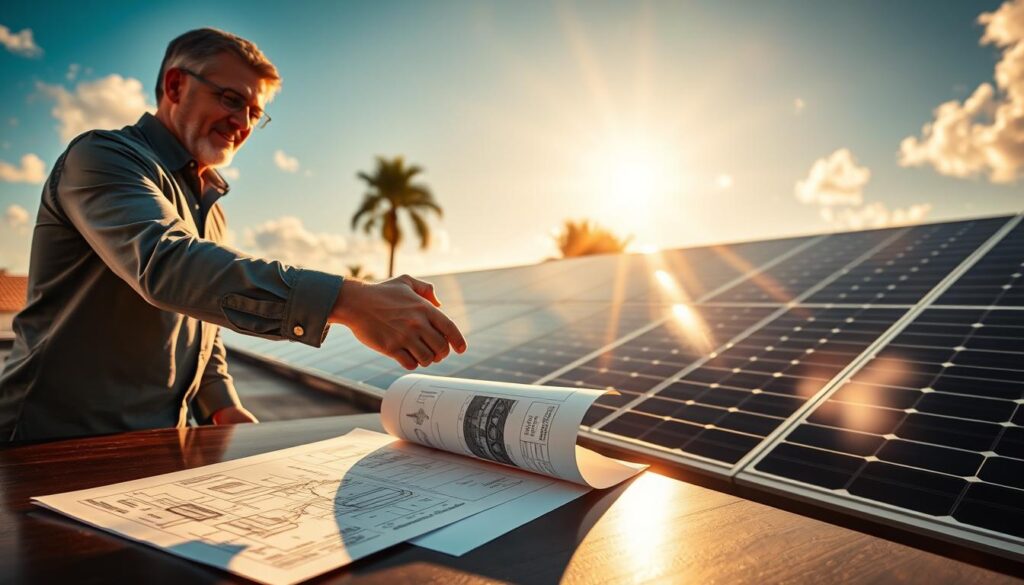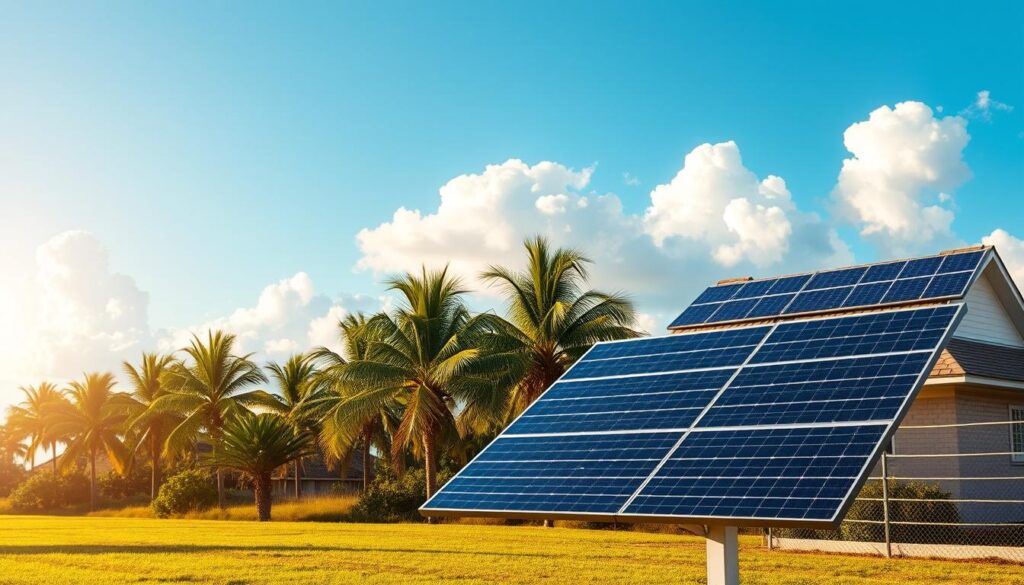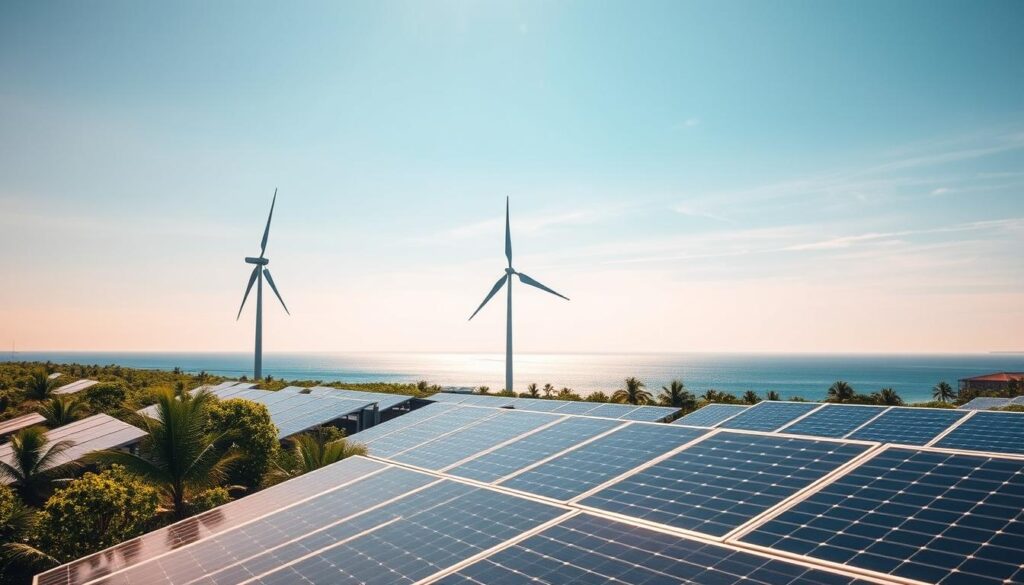Do you get free solar panels in Florida? Many homeowners explore ways to install solar with no upfront costs. While truly free panels aren’t available, programs like leases, power purchase agreements (PPAs), and financing options make solar energy affordable. Florida’s incentives, including a 30% federal tax credit and net metering, help reduce expenses over time.
Key Takeaways
- Zero-down options like PPAs and leases offer free solar panels in florida with no initial payment.
- Owning a system unlocks a 30% federal tax credit, lowering total costs.
- Net metering allows you to earn credits by selling unused energy back to the grid.
- Homeowners can save up to $50,000 over 25 years through solar ownership.
- Florida Power Services holds a 4.8/5 rating for solar installations, ensuring quality options.
Understanding Solar Panel Incentives in Florida
Going solar in Florida becomes easier with the right financial support. Let’s break down the solar panel incentives and solar panel rebates florida that can cut costs significantly.
Federal Tax Credits for Solar Energy
The solar panel incentives start at the federal level. Homeowners qualify for a 30% tax credit on installation costs. For a $25,200 system, this saves around $7,560. This credit applies to system costs and even includes battery storage like Tesla Powerwalls.
State Incentives and Rebates
- Property Tax Exemptions: Solar systems are exempt from property taxes, saving $218 yearly on average.
- Sales Tax Exemptions: Florida waives its 6% sales tax on solar purchases, saving $1,440 on a $24,000 system.
- Rebate Programs: Boynton Beach offers $1,500 for systems over 5kW. Dunedin’s program provides up to $2,500 per installation.
Local Utility Programs
Utilities like Florida Power & Light and Gulf Power offer solar panel rebates florida through net metering. Homeowners earn bill credits at full retail rates for excess energy sent to the grid. Programs like the Solar and Energy Loan Fund (SELF) provide low-interest loans starting at 7.99%, making upfront costs manageable.
What Does “Free Solar Panels” Mean?
When companies promote free solar panels in Florida, they usually refer to payment plans where providers cover upfront costs. These programs like the Florida Solar Program allow homeowners to install systems without initial payments, but terms vary widely. The reality involves trade-offs between cost savings and long-term obligations.

“No-cost solar installations are available, but they come with long-term agreements,” according to the Florida Solar Program.
Many free solar panels deals fall into three categories:
- Leases: You pay a monthly fee for system use.
- PPAs: You pay for energy generated at a set rate.
- PACE Loans: Loans tied to property taxes for system financing.
Florida’s average system costs between $10,000–$30,000, but these programs shift initial expenses to providers.
PPAs let you pay per kWh produced at rates below utility prices. Contracts often last 15–25 years. While florida solar program incentives may reduce costs, providers retain system ownership. Homeowners avoid tax credits since they don’t own the panels.
Ownership grants access to federal tax credits (30% of system cost) and SREC sales opportunities. Leases transfer maintenance to providers but lock users into payment plans. Selling a home with leased panels requires transferring the contract or buyingout terms.
Always review terms carefully. While free solar panels reduce upfront costs, long-term expenses could exceed buying outright. Compare agreements to align with your budget and goals.
Who Is Eligible for Free Solar Panels?
Do you get free solar panels in Florida? While fully free solar systems are rare, eligibility depends on ownership, income, and property conditions. Most programs require homeownership, but some income-based initiatives open doors for renters or lower-income households through state-backed options.
Homeowners vs. Renters
Most free solar programs prioritize homeowners. Property ownership is key because lenders or providers need collateral. However, some statewide solar initiative programs partner with renters through community solar projects or landlord-assisted installations. For instance, the Florida Property Assessed Clean Energy (PACE) program allows homeowners to finance solar through property taxes.
Income-Based Programs
- PACE Financing: Available to homeowners earning up to 80% of area median income in certain counties.
- Duke Energy Rebates: Low-income households may qualify for $500–$2,000 rebates via utility partnerships.
- Florida Energy Assistance Program (FEAP): Provides grants for energy upgrades, including solar, for households below 200% of the federal poverty level.
Environmental Impact Criteria
Roof suitability and sunlight exposure are critical. Eligibility requires:
| Factor | Requirement |
|---|---|
| Rooftop Condition | No structural issues; roofs must last at least 10 years |
| Shade Exposure | Roof must receive direct sunlight for 6+ hours daily |
| Space Availability | Enough roof space for 3–5kW systems |
Florida’s statewide solar initiative also evaluates environmental benefits, prioritizing systems that reduce carbon emissions by at least 15% annually. Property owners must submit a site assessment report for approval.
How to Evaluate Solar Providers
Choosing the right solar provider ensures your solar panel installation florida meets quality and affordability standards. Start by prioritizing licensed installers with proven experience in local projects.
Researching Local Solar Companies
Verify providers hold valid Florida solar installer licenses and insurance. Check their history of projects in your area. Look for companies offering affordable solar panels without sacrificing quality. Ask for references and past client testimonials.
Checking Reviews and Ratings
- Review platforms like Google, Yelp, and the Better Business Bureau (BBB).
- Watch for consistent positive feedback and prompt issue resolution.
- Be wary of overly generic reviews—specific details signal authenticity.
Asking for Comprehensive Quotes
Request detailed quotes listing all costs, including permits and warranties. Compare quotes from 2–3 providers to ensure affordable solar panels. Ask about:
- Tax credit coordination (e.g., Federal ITC eligibility)
- Warranty terms for equipment and labor
- Guarantees against performance issues
| Factor | Checklist Items | Purpose |
|---|---|---|
| Licensing | State certification, insurance proof | Avoid legal and safety risks |
| Transparency | Written guarantees, payment plans | Prevent hidden costs |
| Experience | Years in business, project portfolio | Ensure technical expertise |
The Role of Government Programs
Government programs like Florida’s statewide solar initiative and local Florida solar program options make solar more accessible. While the state lacks a statewide rebate, programs like the Property Assessed Clean Energy (PACE) help finance installations through property taxes. Explore how these policies boost solar adoption across Florida.

Local incentives vary by city. Here’s what’s available:
| City | Rebate Amount | Details |
|---|---|---|
| Boynton Beach | $1,500 | One-time rebate for solar or EVs |
| Dunedin | Up to $2,500 | 25 cents per watt, funding-dependent |
| Beach Cities (Jacksonville) | $1,250 max | Applies to solar appliances |
The Sunshine State Incentive (Property Tax Abatement) stops tax increases from solar systems until 2037. This law helps homeowners save over $1,500 annually on energy bills. Pair this with the 30% federal tax credit (2024) to maximize savings.
| Year | Tax Credit % |
|---|---|
| 2024 | 30% |
| 2033 | 26% |
| 2034 | 22% |
The Installation Process Explained
Installing solar panels in Florida involves clear steps to ensure efficiency and safety. From start to finish, homeowners can expect a structured process designed to minimize disruptions. Let’s break down how solar panel installation florida works.
“A well-planned installation ensures systems last 25+ years with minimal upkeep.” — Solar Energy World
Initial Consultation and Assessment
Experts first evaluate your roof’s condition, shading, and energy needs. They calculate the optimal panel count and layout. This phase also includes discussing options like affordable solar panels and financing. Permits are filed with local authorities, which may take 2–4 weeks depending on the county.
Installation Timeline and What to Expect
- Day 1-3: Crews installs panels, wiring, and inverters
- Weeks 1-2: Permit approvals and pre-installation checks
- Final Step: Utility company connects to the grid
Most installations wrap in 1–3 days, but total setup can take 4–8 weeks. Solar Energy World offers 24-hour emergency support during and after installation.
Maintenance and System Monitoring
Regular inspections ensure optimal performance. Most systems come with 25-year warranties. Use apps to track energy output and savings. Cleaning panels twice a year keeps them efficient. With proper care, affordable solar panels can cut energy costs by 20–30% annually.
Potential Financial Benefits of Solar Panels

Switching to renewable energy options in florida can boost your wallet and home value. Solar power reduces utility bills and offers long-term returns through incentives like net metering and tax credits. Affordable solar panels paired with state programs make this investment pay off over time.
Long-Term Savings on Electricity Bills
Florida’s net metering policies let homeowners earn credits for excess energy. A 5kW system can cut monthly bills by up to 50%, saving $840 annually. Over 25 years, this adds up to $21,000 in savings.
- Net metering credits offset 90% of energy costs
- Solar Renewable Energy Credits (SRECs) provide extra income
- Protection from rising utility rates
Increases in Property Value
A 2023 study by the National Renewable Energy Laboratory found homes with solar sell for 4.1% higher than non-solar homes. A $20,000 system increases equity by up to $8,200 immediately.
| Year | Cost Savings | Property Value Gains | Total Net Benefit |
|---|---|---|---|
| 5 | $4,200 | $3,800 | $8,000 |
| 10 | $8,400 | $7,600 | $16,000 |
| 20 | $16,800 | $15,200 | $32,000 |
Environmental Benefits and Savings
Lower carbon emissions reduce future carbon tax liabilities. Health savings from cleaner air could total $500/year per household, per EPA estimates.
“Solar systems in Florida cut energy-related healthcare costs by up to 15%,” says the Florida Solar Energy Center.
- Avoid $2,000 in potential carbon taxes by 2030
- State sales tax exemptions save $1,200 on $20k systems
Florida’s renewable energy options also reduce reliance on fossil fuels, stabilizing energy costs long-term.
Common Misconceptions About Free Solar Panels
Many Floridians wonder, “Do you get free solar panels in Florida?” The truth is nuanced. While free solar panels sound appealing, most programs require repayment through long-term contracts. Let’s clear up common myths.
Clarifying No-Cost Options
- “Free” often means loans or leases where companies own the panels
- No state or federal programs give solar panels outright (0% direct grants)
- Systems are paid for via energy bills over time
Understanding Hidden Fees
Contracts may hide costs like:
- Escalating monthly payments
- End-of-term buyout fees
- Maintenance charges
| Myth | Facts |
|---|---|
| Solar eliminates all bills | Still pay utility connection fees ($25/month average) |
| Panels damage roofs | Properly installed systems increase roof lifespan by protecting surfaces |
| Hurricanes ruin panels | Florida-certified panels withstand 140mph winds |
Myths About Solar Energy Systems
Myth: Solar causes cancer. Fact: WHO confirms panels emit no harmful EMFs. Myth: HOAs block solar. Fact: Florida law prohibits HOAs from banning installations. Myth: Solar saves 100% on bills. Fact: Most systems offset 60-80% usage.
Reputable providers like Eau Gallie Electric offer 25-year warranties. Always review contracts carefully—even “free solar panels” require long-term commitments.
Tax Implications and Considerations
Choosing solar panels in Florida involves understanding how federal and state tax policies can save you money. The solar panel incentives and solar panel rebates florida programs simplify costs while boosting long-term savings.
How Tax Credits Work
The federal solar tax credit allows homeowners to claim 30% of their installation cost as a tax credit, not a rebate. For example, a $10,000 system grants a $3,000 credit. This credit applies to purchased systems only and phases down after 2032:
| Year | Credit Percentage |
|---|---|
| 2023–2032 | 30% |
| 2033 | 26% |
| 2034 | 22% |
Deductions for Solar Installation
- Florida exempts solar equipment purchases from the state’s 6% sales tax.
- Property taxes ignore solar system value, saving up to $250 annually.
- Homeowners can deduct loan interest if financed through mortgages tied to solar upgrades.
Future Tax Liabilities
Unused credits carry over to future tax years. Credits apply only to systems owned by homeowners, not leased ones. For vacation homes, credits are prorated by occupancy time. For instance, living in a vacation home 3 months yearly reduces the credit to 25% of the total. Always file IRS Form 5695 when claiming credits.
Florida’s net metering laws since 2008 ensure credit-for-credit electricity savings, lowering yearly bills by $7,560 on average. Pair this with state-specific solar panel rebates florida to maximize returns.
Understanding Contracts and Agreements
Navigating contracts for Florida solar programs requires careful attention to details. Contracts for renewable energy options in Florida often include long-term terms and hidden fees. Before signing, review every clause to avoid surprises later.
Key Terms to Look For
- Duration: Most agreements last 20–25 years. Shorter terms might allow early buyout options.
- Payment escalators: Clauses raising monthly fees over time can increase costs.
- Performance guarantees: Systems must meet energy output targets to avoid penalties.
- Maintenance responsibilities: Who covers repairs or replacements? Check if the provider or homeowner handles this.
Cancellation Policies
Review exit strategies carefully. Many contracts charge fees for early termination. For example:
- Penalties may apply if you sell your home before the contract ends.
- Transferring agreements to new owners could require provider approval.
“Never assume verbal promises are binding—always request written confirmation.” – U.S. Department of Energy Solar Tips (March 2023)
The Importance of a Written Agreement
Written contracts protect both parties. Ensure all terms, including system ownership rights and tax credit allocations, are clearly stated. For instance, under PPAs, tax credits go to installers, not homeowners. Clarify how this affects monthly payments.
Contracts must outline end-of-term choices like system buyouts or removal. Skipping this step could leave you tied to costly long-term terms. Always consult a legal advisor before finalizing agreements.
Moving Forward with Solar Energy in Florida
Ready to take the next step toward solar energy? Explore renewable energy options in Florida and join the statewide solar initiative. This section outlines actionable steps to turn your solar goals into reality.
Steps to Take After Deciding on Solar
Start by researching certified installers listed on the Florida Solar Energy Industries Association directory. Compare quotes from at least three providers, ensuring they include details like system size and warranty terms. Review contracts carefully, noting ownership clauses and payment schedules. Homeowners choosing ownership qualify for the 30% Federal Solar Investment Tax Credit, while PPA users cannot claim tax credits.
Finding Community Resources
Local programs like the Boynton Beach Energy Edge Rebate and Dunedin Solar Energy Grant offer direct financial support. Attend workshops hosted by the Florida Clean Energy Center to learn about statewide solar initiatives. Join online forums like Solar United Neighbors Florida to connect with other adopters. Utilities like JEA and OUC provide battery rebates and technical support, enhancing system efficiency.
What’s Next After Installation?
Monitor your system’s performance using apps like SolarEdge or Enphase Enlighten. Track utility bills to see net metering credits for surplus energy fed into the grid. Optimize energy use by aligning high-usage appliances with peak sunlight hours. Selling Solar Renewable Energy Credits (SRECs) adds extra income, with each MWh generating tradable certificates. Florida’s property tax exemption keeps solar systems tax-free, boosting long-term savings.
